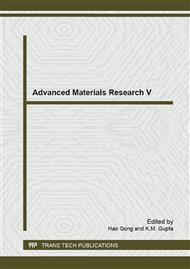p.56
p.62
p.69
p.74
p.78
p.83
p.88
p.93
p.99
The Role of Twinned and Detwinned Structures on Memory Behaviour of Shape Memory Alloys
Abstract:
Shape memory alloys have a peculiar property to return to a previously defined shape or dimension when they are subjected to variation of temperature. Shape memory effect is facilitated by martensitic transformation governed by changes in the crystalline structure of the material. Martensitic transformations are first order lattice-distorting phase transformations and occur with the cooperative movement of atoms by means of lattice invariant shears in the materials on cooling from high temperature parent phase region. The material cycles between the deformed and original shapes on cooling and heating in reversible shape memory effect. Thermal induced martensite occurs as twinned martensite, and the twinned martensite structures turn into detwinned structures by deforming the material in the martensitic condition. Deformation of shape memory alloys in martensitic state proceeds through a martensite variant reorientation. The deformed material recovers the original shape on first heating over the austenite finish temperature in reversible and irreversible shape memory cases. Meanwhile, the parent phase structure returns to the twinned structure in irreversible shape memory effect on cooling below to martensite finish temperature and to the detwinned structure in reversible shape memory effect. Therefore, the twinning and detwinning processes have great importance in the shape memory behaviour of the materials. Copper based alloys exhibit this property in metastable β-phase region, which has bcc-based structures at high temperature parent phase field, and these structures martensitically turn into layered complex structures with lattice twinning following two ordered reactions on cooling.
Info:
Periodical:
Pages:
78-82
Citation:
Online since:
May 2015
Authors:
Price:
Сopyright:
© 2015 Trans Tech Publications Ltd. All Rights Reserved
Share:
Citation:


